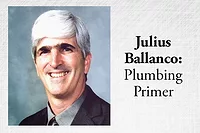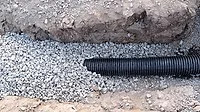Engineering Combustion Air
Julius Ballanco

In the October 2007 issue of PM, I wrote an article titled, “Water Heater and Boiler Combustion Air.” Many of you contacted me asking for information on engineering combustion air. So this month let me review how you can engineer the design for combustion air for a water heater or boiler.
Before I begin, let me forewarn you that not all inspectors understand how to evaluate an engineered combustion air design. Heck, I have had the experience where certain members of the staff of ICC didn’t understand how to engineer combustion air. It is easier to read numbers in a book rather than think about what they mean. But remember, the codes all allow engineered design of combustion air.
You first need to reference an engineering document that provides the amount of air required for combustion air. My recommendation is to always use a mechanical engineering handbook. Feel free to use the following statement: “Table 44.1 in the Mechanical Engineering Handbook, second edition; Myer Kutz, Editor; published by Wiley Interscience; specifies a volume of 9.53 cubic feet of air for perfect combustion for every one cubic foot of natural gas.”
As you know, natural gas is predominantly methane or CH4. The heating value ranges, but is typically identified as being approximately 1,000 Btu/cubic foot. If you want to know what it really is, look on your local gas bill and it is normally indicated. My gas utility lists the heating value as 1,007 Btu/cubic foot. What all this means is that for every 1,000 Btu/hr. of input rating of the appliance, you need 9.53 cubic feet/hr. of air for combustion.
However, when dealing with combustion air, you also need to add excess air to assure that combustion is complete. The standard rule for engineers is to add 10 percent excess air for complete combustion of a fuel-fired appliance.
You also need to add draft hood dilution and ventilation air. The standard rule for engineers is to add 20 percent additional air for draft hood dilution and ventilation. If you were keeping track of those numbers, it equates to 12.5 cubic feet of air per hour required for every 1,000 Btu/hr. of input rating of the appliance.
This is the magic number.
You may be asking, “What if I have LP gas rather than natural gas?” Well, the numbers do change. LP gas is predominantly propane, with possibly some butane, propylene and butylene. We tend to use the propane numbers for evaluation.
That same book I referenced specifies a volume of 23.8 cubic feet of air for every cubic foot of propane. However, the heating value of propane is much higher. The heating value is typically listed as 2,512 Btu/cubic foot, or rounded off to 2,500 Btu/cubic foot.
When you convert to Btu/hr. of input rating and add all the excess air, the final number works out to 12.5 cubic feet per hour of air for every 1,000 Btu/hr. of input rating. See why the 12.5 is such a magic number? You can use it for any fuel. I always say that the Good Lord was nice to us by making it an easy number to use for any fuel.
It Figures
Now that you know how much air is required, all you have to do is figure out how to get that air into the room with the appliances. You can either get very complex, or keep it very simple when evaluating air movement.One of the beauties of the combustion process is that there is a negative pressure zone at the base of a flame. In other words, the flame draws air in from the surrounding area. We basically ignore the negative pressure aspect of the flame when determining air movement. The negative pressure zone can be considered part of your factor of safety.
In the ASHRAE Handbook of Fundamentals, the movement of air is discussed in detail. One of the chapters discusses normal air movement through doors, louvers and door undercuts.
As all of you recognize, air is always moving inside a building. The question is, how fast is it moving? The values listed by ASHRAE are 200-300 feet per minute. I should mention that the fuel gas and mechanical codes have always assumed velocities of 100-300 feet per minute, normally selecting the lower value of 100 feet per minute. If the movement can be 300 feet per minute, I recommend selecting this value. If you want to be conservative, select 200 feet per minute.
Using the numbers I have provided, you now can begin to engineer the combustion air for your appliances. It is just a matter of keeping your dimensions straight.
If you have a 12-inch by 12-inch opening, how much air will flow through it in an hour? How large of an appliance can it serve?
Notice that I made the opening 1 square foot. That means in a minute, 300 cubic feet of air will flow - or if you are conservative, 200 cubic feet of air. For an hour (60 minutes), that increases to 18,000 cubic feet of air or 12,000 cubic feet of air, again depending on what you select.
To determine the appliance this can serve, you simply divide by 12.5 cubic feet of air per hour for every 1,000 Btu/hr. of input rating. That translates to either 1.44 million Btu/hr. or 960,000 Btu/hr. If we used the very conservative value of 100 feet per minute, the opening would provide combustion air for 480,000 Btu/hr. Still, quite a large appliance for a not-so-large an opening.
Remember the code requirement that stipulates 1 square inch per 4,000 Btu/hr. input. The 480,000 Btu/hr. number - using the 100 feet per minute - comes very close to 1 square inch per 4,000 Btu/hr. Divide the 480,000 Btu/hr. by 4,000 and you have 120 square inches, which is a 12-inch by 10-inch opening, a difference of 24 square inches.
If you add duct for the connection to the opening, you must calculate the pressure loss through the duct. This will, of course, slightly increase the size of the opening.
Nothing But Air
As soon as these numbers seem outrageous to you, do another calculation. Let’s figure the velocity of air flow in a 2-inch PVC pipe supplying combustion air to a 100,000 Btu/hr. appliance.If the inside diameter is exactly 2 inches, the inside area would be 3.14159 square inches. Converting that to square feet, you have 0.0218 square feet. The 100,000 Btu/hr. appliance would require 1,250 cubic feet per hour of air. Dividing out the numbers, it comes to a velocity of approximately 950 feet per minute flowing through the pipe.
That is not that high, since the air is forced through the pipe with the help of a fan. It should be noted that the value of 1,250 cubic feet per hour is also high.
For a direct vent appliance, you don’t need to figure on ventilation and draft hood dilution air. Hence, the actual amount of combustion air necessary would be closer to 10 to 10.5 cubic feet per hour. The velocity would work out to being closer to 800 feet per minute. Again, not a high velocity in a conduit or pipe.
Remember that the air must come from somewhere. These values assume either outside air, or spaces directly communicating with the outdoors, such as the attic or crawl space.
Now you have the tools to engineer combustion air. This will provide you with much smaller openings and less likelihood of frozen pipes near appliances.
Looking for a reprint of this article?
From high-res PDFs to custom plaques, order your copy today!








